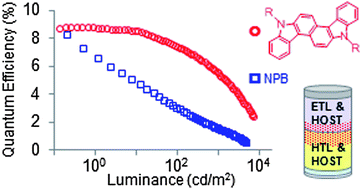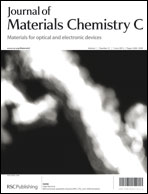A new series of carbazolo[4,3-c]carbazoles (1–3) have been examined as hole-transporting and emitting host materials in the fabrication of red phosphorescent OLEDs (PhOLEDs). The presence of different N-substituents including hydrogen, octyl and 4-butylphenyl attached to the carbazolo[4,3-c]carbazole skeleton was aimed to condition the charge transporting properties. Due to their resemblance in the electronic structure, these carbazolocarbazoles have been compared to a commonly used hole-transporting material such as N,N′-bis(naphthalen-1-yl)-N,N′-bisphenylbenzidine (NPB). Interestingly, the introduced structural differences endow compounds 1–3 with a wide range of hole-mobilities, which provide room for adjusting the carrier balance of OLEDs. Different approaches, including bi-layer and tri-layer architectures, have been employed for the successful fabrication of Ir(piq)2(acac) doped OLEDs using NPB and these novel carbazolocarbazoles as hole transport and host materials. The simplified bi-layer device demonstrated high performance with maximum efficiencies of 8.7%, 5.6 cd A−1 and 3.4 lm W−1 when using the N-alkylated derivative 2. Furthermore, the red PhOLEDs with tri-layer architecture using 3 as the HTL showed peak efficiencies of 12.2%, 8.7 cd A−1, and 9.3 lm W−1. In addition, both compounds 2 and 3 used in OLEDs exhibited superior performance to those of devices using NPB, demonstrating their high potential for employment in phosphorescent OLEDs.


 Please wait while we load your content...
Please wait while we load your content...